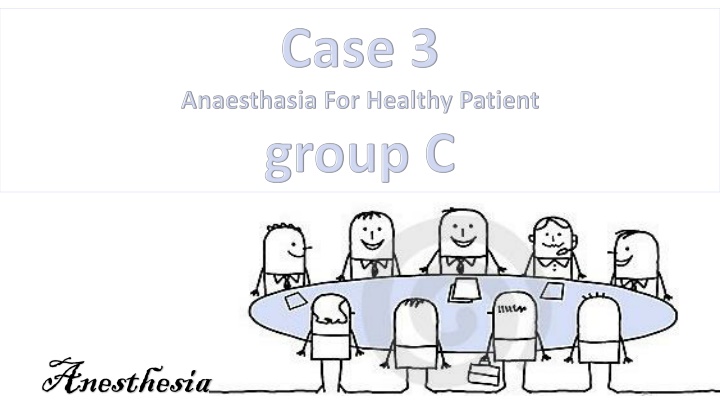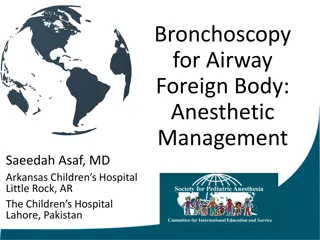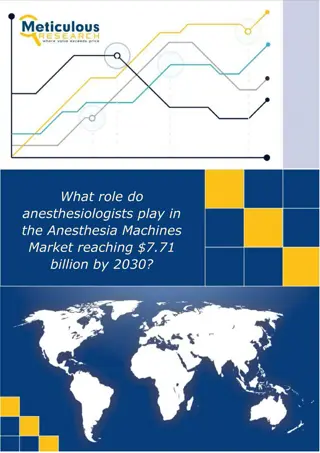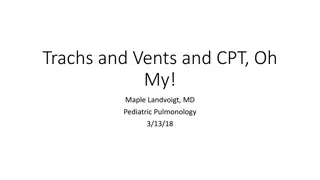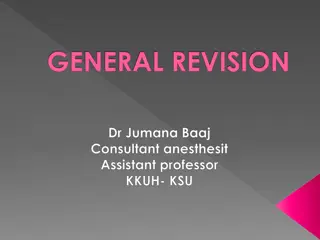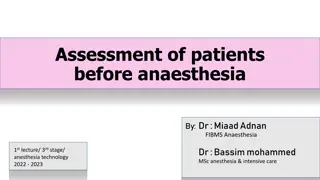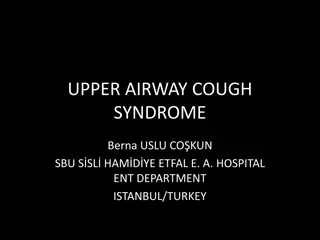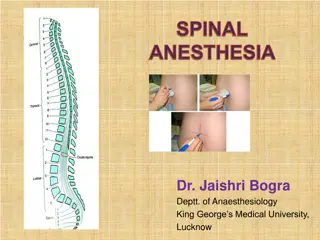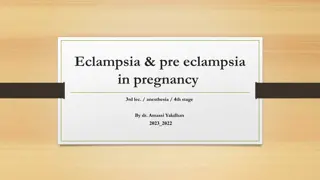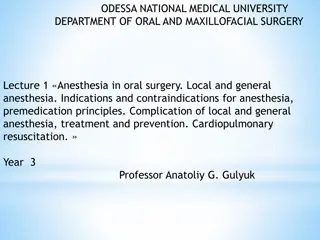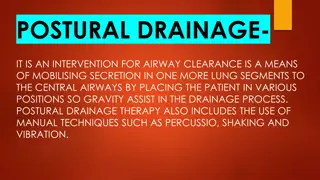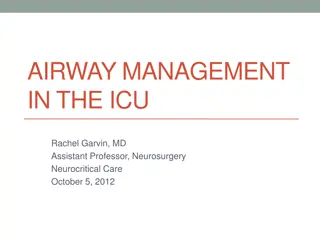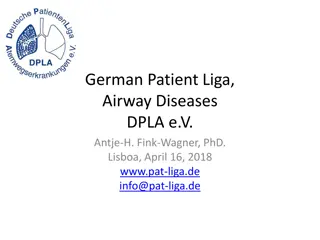Anesthesia and Airway Assessment: Important Considerations
In this content, you'll discover insights on anesthesia, ASA classifications, airway assessment, patient history elements, general examination, tests for intubation difficulty, and a checklist for sign-in procedures before anesthesia. The importance of assessing a patient's general medical condition and airway for safe anesthesia administration is emphasized.
Download Presentation

Please find below an Image/Link to download the presentation.
The content on the website is provided AS IS for your information and personal use only. It may not be sold, licensed, or shared on other websites without obtaining consent from the author.If you encounter any issues during the download, it is possible that the publisher has removed the file from their server.
You are allowed to download the files provided on this website for personal or commercial use, subject to the condition that they are used lawfully. All files are the property of their respective owners.
The content on the website is provided AS IS for your information and personal use only. It may not be sold, licensed, or shared on other websites without obtaining consent from the author.
E N D
Presentation Transcript
Scenario Scenario
How are a patients general medical condition ASA standard classifications? - ASA stage 2 First question
Discussthe airway assessment for this patient ? Airway assessment Traditionally, the gold standard of airway management is tracheal intubation, and the majority of assessments relate to the ease or difficulty of this process. Second question
In history ask about: Past anesthetic history Surgery/radiotherapy to head and neck. Obstructive sleep apnea (OSA). Conditions affecting tongue size (e.g. acromegaly, infections, tumors) Conditions affecting neck mobility (e.g. ankylosing spondylitis, infections, tumors). Conditions affecting mouth opening (e.g. temporomandibular joint dysfunction). Second question
General examination This includes: Look for external signs of surgery/radiotherapy to head and neck. Assess the airway from in front of the patient, including: receding jaw, protruding upper incisors, large tongue, large neck, obesity. Tumors, infection, trauma, swelling or burns and scarring of the airway strongly suggest problems. Second question
Tests: include: mouth opening: this should be 4 6cm; Mallampati classification (Figure 16.2): on full opening of the mouth the facial pillars, uvula and soft palate sequentially disappear; scores of 3 and 4 are associated with difficult intubation. Movement of the jaw, i.e. ability to protrude the lower teeth in front of the upper teeth; Thyromental distance (chin to thyroid notch): this should be >6cm. Sternomental distance (chin to sternum): this should be >12.5cm. atlanto-occipital mobility: this is difficult to assess >> radiological imaging. Second question
Third question What is the check list for sign in Sign in occurs before anesthesia The patient s details are checked, as well as the operation, consent, appropriate marking of site, allergies, potential airway issues and the anticipated blood loss. Identity Site Procedure Consent Patient has confirmed Site marked/not applicable Anesthesia safety check completed Pulse oximeter on patient and functioning No Yes No Yes, and equipment/assistance available No Yes, and adequate intravenous Does patient have a Known allergy? Difficult airway/aspiration risk? Risk of >500mL blood loss (7mL/kg in children)?
Discuss anesthesia plan for this patient. 1) Preoperative Management: Patients attend a preoperative assessment clinic. Questionnaires filled out in advance identify patients needs. Anesthetic consent should be taken. Discusstype of anesthesia (e.g. local vs. general) Explain the side effects: common side effects, e.g. postoperative nausea and vomiting. 2)Intraoperative Management: To establish IV access. Apply monitoring: 1. ECG. 2. pulse oximeter. 3. non-invasive blood pressure. before moving into the operating theatre. Airway must be secured (e.g. with an LMA or endotracheal tube). Then further motoring/interventions are performed (e.g. nasogastric tube urinary catheter insertion occur, if indicated. Fourth question
3) Postoperative Management: At the end of the operation, the patient is either: extubated in the operating theatre (and an oropharyngeal airway inserted if needed). or transferred to the recovery room with an LMA still in situ. All patients receive supplemental oxygen during transfer. Once in the recovery room, we should check on: 1. patients name and age. 2. operation details. 3. blood loss 4. analgesia given 5. antiemetic's given 6. Antibiotics 7. thromboprophylaxis. Patients stay in the recovery room until they are: 1. awake and in complete control of airway reflexes. 2. pain free. 3. no/minimal nausea and vomiting. 4. no/minimal bleeding from surgical site. 5. normothermic. Fourth question
Discuss the chick list for time out. Time out occurs in the operating theatre before the start of the operation. The team should double check: 1. ID of the patient 2. planned operation and site (including anticipated blood loss) 3. Any medical concerns about the patient. A check of availability of all equipment and imaging for the proposed operation is also established. Fifth question
Sixth question Discuss the safety features of anesthesia machine Non-interchangeable screw threads (NISTs) prevent the incorrect pipeline gas being connected to the machine inlet. A pin index system is used to prevent incorrect cylinder connection. Barotrauma to both patient and machine is avoided by using pressure reducing valves/regulators and low restrictors. The oxygen failure warning alarm is pressure driven and alerts of imminent pipeline or cylinder failure. Accurate gas delivery: flow delivered through the anesthetic machine give a digital representation. Hypoxic guard: Oxygen is delivered distal to N2O within the rotameter, preventing hypoxic gas delivery if the O2 rotameter is faulty or cracked. Interlocking vaporizers on the back bar prevent two anesthetic vapours being given simultaneously. Ventilator alarms warn of high and low pressure. Emergency oxygen flush: when pressed, oxygen bypasses the back bar and is delivered to the CGO at >35 L/min. This must be used with caution as gas is delivered at 4 bar and does not contain anesthetic. Suction: adjustable negative-pressure-generated suction is used to clear airway secretions/vomit and must be available for all cases. Scavenging of vented anesthetic gases is active, passive or a combination. Scavenged gases are usually vented to the atmosphere. Scavenging tubing has a wider bore (30mm), preventing accidental connection to breathing circuits.
Low gas flows reduce environmental impact and cost. Operating theatre air exchange occurs through the air conditioning system (e.g. 15 times per hour). The main aim is infection control; it also serves to remove unscavenged gases. Sixth question
